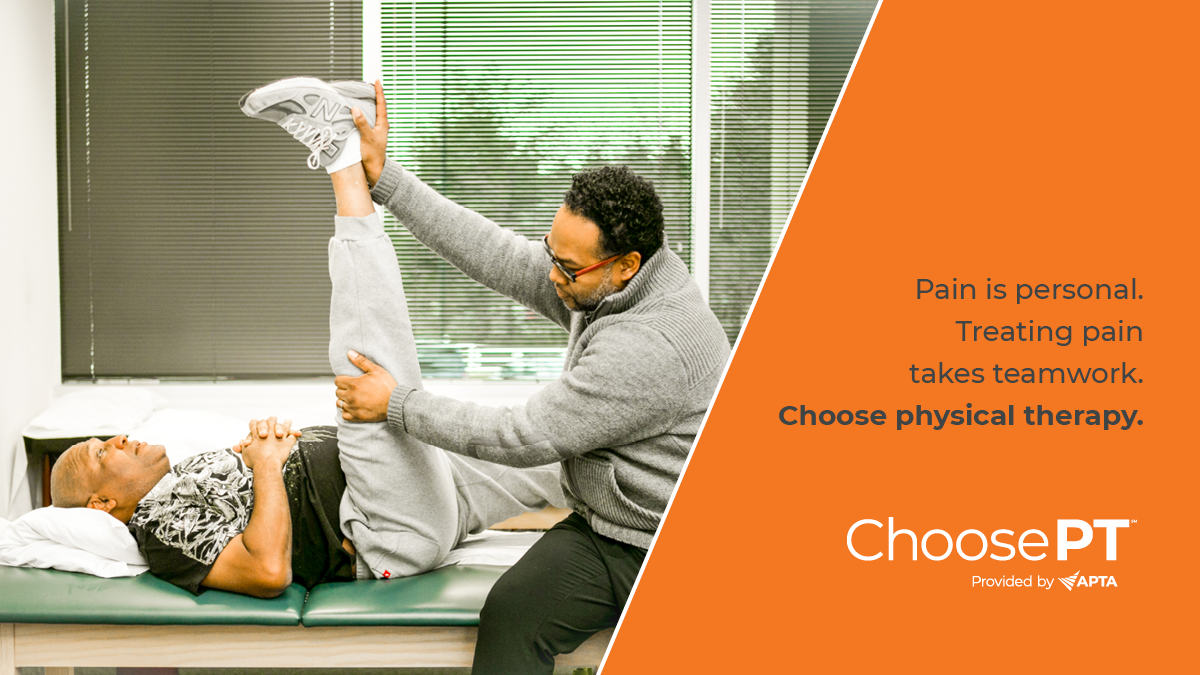If you experience an injury or develop the onset of pain, seeing a physical therapist early can help you address and manage your symptoms. Physical therapists are movement experts who improve quality of life through hands-on care, patient education and prescribed movement. A physical therapist can help you:
Get better safely and without fear of causing further injury.
Stay physically active and avoid the cost and potential risks of surgery and prescription opioids.
Recover as soon as possible.
Avoid other problems caused by changes your body makes to avoid pain.
Achieve your goals.
Acute Versus Chronic Pain
Acute pain—Typically, the first two to three weeks after an injury is called the acute phase. During this phase, it is easier to diagnose and treat pain.
Chronic pain—Pain lasting longer than three months is considered chronic. Identifying the cause of chronic pain is more complicated, and treating chronic pain takes longer.
A recent study, published in May 2020 in Archives of Physical Medicine and Rehabilitation, found that people who get physical therapy early after the onset of low back pain have much better results than those who wait. Other studies, such as an October 2015 article published in JAMA and a July 2020 article published in The Mental Health Clinician, have shown that early physical therapy improves disability and decreases pain and reduces the need for medication.
Seeing a physical therapist early in the acute phase of pain or injury often leads to the best results.
Five Benefits of Early Physical Therapy for Pain
1. Get Better Safely, Without Fear of Causing Further Injury
Pain may cause you to avoid activity for fear of causing more damage. After a thorough evaluation, your physical therapist will design a personalized plan of care based on your needs and goals to:
Improve and manage your pain.
Safely improve movement, function and quality of life.
Recover from injury and prevent future injury.
Physical therapists often work with other members of your health care team to ensure the best possible care.
2. Stay Physically Active To Avoid the Cost and Potential Risk of Surgery and Prescription Opioids
When an injury or pain occurs, our body enters protection mode. Often, people in pain avoid moving altogether. But avoiding all activity can delay recovery and lead to new problems.
To recover from most causes of pain, it’s important to keep moving. An active lifestyle that is appropriate for your condition can help you manage symptoms and decrease or eliminate pain. A physical therapist will help you:
Understand your pain.
Set realistic expectations for recovery.
Prescribe exercise specific to your condition, needs and goals.
A physical therapy program may help you avoid or delay surgery and can help you properly prepare for surgery, if required. Physical therapy also is recommended by the Centers for Disease Control and Prevention as a safe and effective alternative to opioids for the management of most non–cancer-related pain. A physical therapist can also help you understand the use of any medication that is best for your condition and show you safe ways to reduce your pain.
3. Recover as Soon as Possible
Those who seek care within two weeks of an injury or onset of pain may require less care. In addition to treating your pain, your physical therapist will help you better understand your symptoms and provide strategies to manage your pain and recovery, as soon as your condition allows.
4. Avoid Other Problems Caused by Chronic Pain
When pain lingers, we may develop new movement patterns to avoid it. As a result, you may develop additional issues that require more time and effort to treat and reverse. Problems that may develop include:
Seeing a physical therapist at the onset of pain may prevent it from becoming chronic.
5. Achieve Your Goals
Movement is crucial to your health, quality of life, and independence. For some people, pain makes movement a challenge. Your physical therapist can discuss your goals and work with you to develop a program to achieve them so you can get back to your desired activities or sport as soon as possible.
You can contact a physical therapist directly for an evaluation. Our Patient Care Coordinators are here to help you understand your insurance benefits and our PTs will help you determine if a visit to your physician is beneficial.
























